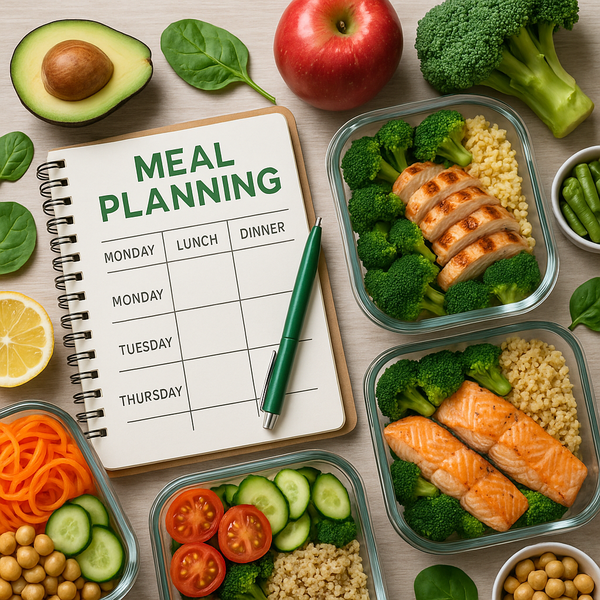
Adopting a meal planning routine can profoundly impact your daily life, simplifying the process of preparing nourishing meals, saving valuable time and money, and reducing stress around deciding what to cook each day. It’s a practical strategy that helps you take control of your dietary habits and manage your household budget more efficiently, making healthy eating an achievable goal rather than a daunting task.
Understanding the Benefits of Meal Planning
Meal planning isn't just about deciding what you'll eat; it's a strategic approach to managing your food consumption and grocery shopping. By dedicating time to plan your meals for the week ahead, you can significantly reduce impulsive grocery purchases and takeout orders, which often leads to saving money. Furthermore, planned meals are typically healthier as they allow you to control ingredients, portion sizes, and cooking methods.
Think about the time saved by knowing exactly what ingredients you need before you go to the store. This minimizes multiple trips and reduces food waste because you only buy what you need for the planned meals. The mental energy saved from not having to figure out dinner each night after a long day is also a considerable benefit, contributing to a less stressful lifestyle.
Getting Started: Assessing Your Needs and Goals
Before you even start choosing recipes, take some time to assess your current situation and what you hope to achieve with meal planning. Consider your household size, dietary restrictions or preferences (allergies, vegetarian, low-carb, etc.), cooking skill level, and the amount of time you realistically have to dedicate to cooking each day or week.
What are your primary goals? Do you want to save money on groceries? Eat healthier? Lose weight? Gain muscle? Spend less time in the kitchen? Having clear goals will help you choose the right types of meals and planning methods that align with your lifestyle and objectives. This foundational step is crucial for creating a sustainable meal planning habit.
Building Your Meal Plan: Step-by-Step
Once you've assessed your needs, it's time to start building the plan itself. Begin by deciding how many meals you need to plan for. Will you plan for breakfast, lunch, and dinner, or just dinner? For how many days? A week is a common cycle, but you could start with just a few days if you're new to this.
Look through cookbooks, blogs, or recipe websites to find meals that appeal to you and fit your criteria (time, skill, diet). Don't feel pressured to cook a brand new recipe every night. Incorporating simpler meals or leftovers can make the plan more manageable. Consider theme nights (Taco Tuesday, Pasta Thursday) to simplify recipe selection.
Creating Your Grocery List
This is where the money-saving aspect really comes into play. Once your meals are planned, go through each recipe and list out every single ingredient you'll need. Then, check your pantry, fridge, and freezer to see what you already have. Cross those items off your list.
Organize your grocery list by store section (produce, dairy, meat, pantry, etc.) to make your shopping trip faster and more efficient. Stick to your list as much as possible to avoid impulse buys. Shopping seasonally can also save money, as in-season produce is often cheaper and fresher.
Meal Prepping for Success
Meal prepping involves preparing components of your meals ahead of time. This could mean chopping vegetables, cooking grains, marinating meats, or even assembling entire meals. Doing this on a day when you have more free time, like a Sunday afternoon, can significantly reduce the time needed for cooking during the busy week.
Consider what parts of your planned meals can be prepped. Hard-boiling eggs for breakfasts, washing and chopping salad greens, cooking a large batch of quinoa or rice, or prepping smoothie packs for the freezer are all great examples. Having ingredients ready to go makes weeknight cooking much faster and less intimidating.
Choosing the Right Tools and Resources
Several tools and resources can aid your meal planning journey. Simple pen and paper work perfectly, but there are also numerous apps and websites designed specifically for meal planning and grocery list creation. Many offer recipe databases and features to adjust serving sizes and track nutritional information.
Having the right storage containers is also essential for keeping prepped food fresh and organized in the fridge or freezer. Look for durable, airtight containers in various sizes. Lunch boxes or bento boxes are great for packing pre-portioned meals for work or school.
Handling Meal Planning Challenges
It's important to be flexible. Sometimes plans change, or you simply don't feel like eating what you planned. Have a few easy backup meals or 'free' nights where you can use leftovers or grab something simple. Don't let a deviation from the plan derail your entire effort.
Another challenge can be finding variety. Make an effort to try new recipes occasionally to keep things interesting and ensure you're getting a wide range of nutrients. Rotate through your favorite recipes to avoid repetition while still enjoying meals you know how to make and love.
Making it a Sustainable Habit
Consistency is key to making meal planning a habit that sticks. Start small if needed, planning just a few dinners or lunches. As you get more comfortable, expand your planning. Schedule a specific time each week for planning and prepping, and treat it as an important appointment.
Celebrate your successes, whether it's saving money, eating healthier, or just feeling more organized. Find a system that works for you, and don't be afraid to adjust it as your needs or lifestyle change. Meal planning is a tool to make your life easier, not another source of stress.
Implementing meal planning into your routine offers substantial benefits, from improved nutrition and reduced food waste to significant savings and less stress. By following these tips and finding a method that suits your individual or family needs, you can transform the way you approach cooking and eating, leading to a healthier, more organized, and budget-friendly lifestyle.

